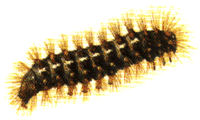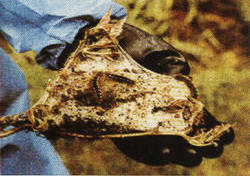Brown Tail Moth
 Brown Tail Moth Caterpillars can be found in many trees and hedgerows. Larvae of this moth carry minute hairs which can cause serious skin and eye irritations if they come into contact with these areas. Large adult larvae may carry up to two million of these hairs.
Brown Tail Moth Caterpillars can be found in many trees and hedgerows. Larvae of this moth carry minute hairs which can cause serious skin and eye irritations if they come into contact with these areas. Large adult larvae may carry up to two million of these hairs.
They feed abundantly on the buds and young leaves of mainly rosaceous trees and shrubs, but will also attach other deciduous trees causing complete defoliation in a short period of time depending on the caterpillar density.
The Brown Tail Moth caterpillar is blackish grey in colour with tufts of ginger brown hairs. The most noticeable feature is the two orange spots near the tail.
 The moths lay 200-300 eggs on the leaves of trees and shrubs in late summer. Small caterpillars hatch and start to feed on the leaves. During this period the larvae construct a conspicuous white silken tent, which is usually found on an exposed branch of the food plant. From 50-2000 individuals overwinter in each tent. In spring the caterpillars emerge from their winter homes and disperse over the foliage. They feed on the leaves until they are approximately 1.5 inches (3.5 cm) in length. At the end of the summer they moult, pupate and emerge as adult moths.
The moths lay 200-300 eggs on the leaves of trees and shrubs in late summer. Small caterpillars hatch and start to feed on the leaves. During this period the larvae construct a conspicuous white silken tent, which is usually found on an exposed branch of the food plant. From 50-2000 individuals overwinter in each tent. In spring the caterpillars emerge from their winter homes and disperse over the foliage. They feed on the leaves until they are approximately 1.5 inches (3.5 cm) in length. At the end of the summer they moult, pupate and emerge as adult moths.
Over the last few years the numbers of these moths has increased greatly specially in the southern parts of the U.K. They can defoliate large trees if they become established in large numbers. Avoid any contact or handling of the caterpillars. Keep windows closed near any infestation. People should seek medical attention if breathing problems occur or a skin irritation persists for more than a few hours. For any minor skin irritation use an antihistamine cream or calamine lotion.
Control Measures
The simplest way of controlling these caterpillars is to inspect your trees in the autumn and remove any tents that you find by pruning the twigs that they are on. The tents should preferably be burnt on site or place in a plastic bag and disposed of in your dustbins. Avoid disturbing the tents whilst removing them and ensure that you protect yourself by wearing gloves.
Contact pesticide sprays can be used for immediate treatment but this is unlikely to eradicate the infestation as the majority of caterpillars stay in the tents. Pesticides that stay active after application and rain are more effective. Good garden centres may be able to give advice on pesticides available.
Points to remember:
- To Prevent these moths spreading cut out tents in Autumn/Winter months
- When dealing with the caterpillars or tents always wear protective clothing
Arrange Pest Control Treatment
Professional treatment can be carried out by our preferred contractor AGS One Pest Control. To get a quote and arrange treatment please contact them either by telephoning 01304 759033 or by emailing pestcontrol@agsone.co.uk